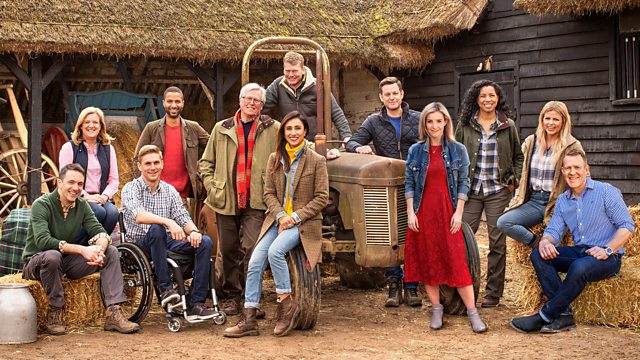
Clwydian Range
Ellie Harrison and Matt Baker are in the Clwydian range which spans Denbighshire and Flintshire in North Wales, where Matt joins the team cutting back heather.
Ellie Harrison and Matt Baker are in the beautiful but little-known Clwydian range which spans Denbighshire and Flintshire in North Wales. Ellie discovers how this landscape influenced 18th-century artist Richard Wilson - said by many to be the father of British landscape painting. She also hooks up with the children of a local primary school where the pupils are turning a tidy profit by running their own chicken farm.
Matt joins the conservation team cutting back the heather in the uplands and meets the brewer putting all those offcuts to good use in his heather-infused ale.
Anita Rani spends the day with the sniffer dogs trained to sniff out not explosives or stolen cash but endangered animals, and Adam takes a look at how cutting-edge science is being used to create the perfect cow.
From stealing priceless objects to stripping the lead from church roofs, heritage crime is a growing problem in the British countryside. Tom Heap investigates what is being done to protect our history.
Last on
Heather grazing

Matt Baker travels to the breath-taking Moel Famau, highest point in the Clwydian range to find out about how preserving these precious uplands is bringing farmers and conservationists together. For centuries local graziers had maintained the uplands heather by cutting and burning, however the practise had almost died out threatening this endangered habitat. Matt drives a specially-adapted tractor, cutting the heather on these precipitous slopes. He then travels to a local farm to meet local grazier Rob Hammond and check on some sheep which have come down from the hills for winter.
Conservation dogs

Anita Rani meets some of the greatest sniffers in the UK to find out about a ground breaking new project to create conservation dogs. Head handler, Aran Clyne, introduces Anita to the animals that are in training to help some of our most endangered British species. She learns why the conservation dogs are more efficient than humans at finding rare creatures. Then Anita puts them to the test sniffing for bat carcasses - an effective way to assess the impact of wind turbines on bat populations - and searching for Great Crested Newts. But will they manage to sniff them out?
Heritage Crime

The British countryside is full of reminders of our rich heritage, from precious artefacts to historic buildings and monuments. But these, often priceless, parts of our history are under threat from thieves and vandals. Tom Heap finds out what is being done to tackle the problem of heritage crime in rural areas and meets those who have been affected by it. He climbs the tower of a church that’s roof has been stripped of lead for the second time in a decade and joins Hertfordshire Police as they investigate the origin of a huge collection of wartime memorabilia, which may have been dug up from private land. Tom discovers what’s being done to tackle the problem and finds out what you can do to help.
School chickens

Just north of the Clwydian Range, Ellie Harrison is in Llandudno, filming at a primary school that has quite a unique take on all things ecological. In their playground they have runs where they keep around 140 chickens, from 20 different breeds, and collect up to 400 eggs a week. The kids do all the looking after - they clean out the coops and collect the eggs twice a day. They also have a whole range of reptiles, from tortoises to geckos to African hedgehogs! Ellie meets the headmaster, Ian, and some of the children to find out more.
Surrogate cows

Adam Henson reaches for the shampoo but it’s not for personal grooming. He is helping with the washing and training of three very young bulls in preparation for their first big show. Once they’re spruced up, Adam travels to Leicestershire to see some rather unusual cows. He meets a farmer who uses a technique called embryo flushing. Fertilised embryos are taken from recently pregnant cows and placed into cattle which are then used as surrogates. This system can produce more high quality calves than if nature was left to its own devices.
Heather beer

Having cut some heather on Moel Famau, Matt is meeting a man who puts it to good use. Phill Blanchard of Hafod Brewery joins Matt on the hillside to select some of the waste heather for his speciality beer. Named after the mountain, Moel Famau Ale is infused with the flavour of smoked heather. Back at brew HQ - Phil’s garage - Matt and Phil set fire to their heather, arranging the malted barley on trays in the smoker to take on the flavour. They then end up in a local pub where Matt can get a taste of the finished product.
Richard Wilson
Ellie visits Llangollen to look at the life and works of Welsh artist Richard Wilson, on the 300th anniversary of his birth. He is relatively unknown these days, but is widely considered the ‘father’ of British landscape painting. He was hugely influential on both Turner and Constable and painted the landscape of North Wales. Ellie finds out more from art historian Peter Lord, who has written extensively on the visual culture of Wales. She also visits the actual spot where Wilson painted one of his pictures and meets local art students who are creating works inspired by the same view.
Credits
| Role | Contributor |
|---|---|
| Presenter | Matt Baker |
| Presenter | Ellie Harrison |
| Presenter | Adam Henson |
| Presenter | Tom Heap |
| Executive Producer | William Lyons |
| Series Producer | Joanna Brame |
Broadcasts
- Sun 14 Dec 2014 18:20
- Mon 22 Dec 2014 01:30�鶹������ҳ��� Two except Scotland & Wales
